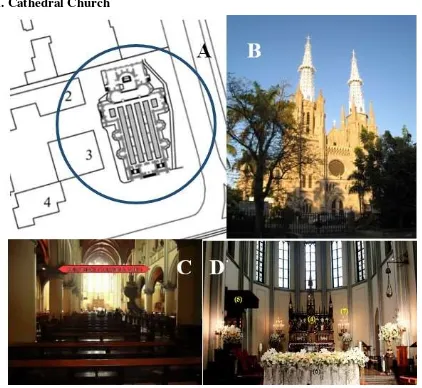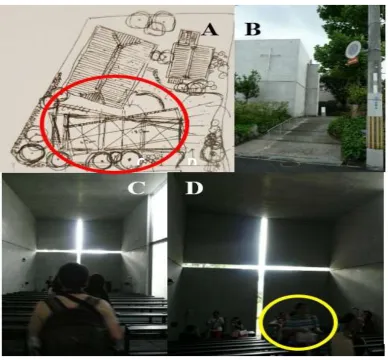Volume 9, Issue 12, December 2018, pp. 209–213, Article ID: IJCIET_09_12_025
Available online at http://www.iaeme.com/ijciet/issues.asp?JType=IJCIET&VType=9&IType=12 ISSN Print: 0976-6308 and ISSN Online: 0976-6316
©IAEME Publication Scopus Indexed
THE MEANING OF NATURAL LIGHTING ON
ALTAR CASE STUDY: CATHEDRAL CHURCH
AND CHURCH OF THE LIGHT
Rudy Trisno
Department of Architecture, Tarumanagara University, Jakarta 11440, Indonesia
Fermanto Lianto
Department of Architecture, Tarumanagara University, Jakarta 11440, Indonesia
ABSTRACT
Natural lighting in the church greatly affects the value of sacredness, because the meaning of light in Christianity is known as father of light. Hence, this issue is very interesting to study. The methodology of this research is; first, the light filter orientation on the altar and sitting room as an audio-visual buffer; second, natural lighting as the center of divine power at the church altar; third, creating a sacred atmosphere which is silent and light. The conclusion in this study is that the orientation of light will give a sacred impression. The lighting on the altar is the climax of the church building, and the orientation of the light on the altar as a climax is the manifestation of silent and light. The finding of this study is that the illumination of the light filter on the altar is not greater than the sitting room which is a zoning of the audio visual buffer. The benefits of this research can be used for the development of church architecture theory and also for practitioners to design church buildings.
Key words: Natural lighting, Altar, Meaning of lighting, Light filter, Audio-visual buffer
Cite this Article: Rudy Trisno, Fermanto Lianto, The Meaning of Natural Lighting on Altar Case Study: Cathedral Church and Church of the Light, International Journal of Civil Engineering and Technology (IJCIET) 9(12), 2018, pp. 209–213.
http://www.iaeme.com/IJCIET/issues.asp?JType=IJCIET&VType=9&IType=12
1. INTRODUCTION
Lighting affects sacredness in church buildings, this is in accordance with the teachings adopted by Christianity, light is believed to have a symbolic role that is directly related to religious human perceptions of sacredness.
Lighting is a sacred embodiment. Based on the description above, special natural lighting is very interesting to be discussed as an issue in architectural design works, especially the Christian church.
This is because in the past, the church always faced west so that the position of the altar is at the end of the building, located in the east position with the intention that natural light will emit light on the altar especially in the morning [2].
The benefits of this research are to add insight to the theory of church architecture and architecture who have built their work on sacred buildings, especially the church.
Sacredness can also be realized through an ambiguous atmosphere. This includes silence- noise, where silence can be a symbol of God's presence. Darkness-light, where absence or existence of light can support the creation of experiences of divine presence; emptiness-profusion, which focuses on differences in rhythm in the arrangement of elements to confirm the hierarchy between profane and sacred areas [3].
Altar located in the sanctuary is the most sacred place, because at the altar there is a communication that connects God vertically with the people horizontally, and this altar illuminated by natural light symbolizes God participates in events in the church. God is the light to illuminate his people so they can do good and right things [4].
In general, natural lighting in the church before the 20th century was in the East where the altar was located, because the altar is the most important place for the church which is the
hierophany area. Each of these sacred spaces is characterized by the existence of hierophany, so that the sacred presence is separated from the cosmic environment that surrounds it and makes it of different qualities [5]. This hierophany becomes a new order so that the center of the cosmos is manifested by Axis-Mundi, which can literally be interpreted as the center of the world.
Regarding the axis-mundi, it is clear that the sacred space has existential value for religious humans; because nothing can begin, nothing can be done without light orientation [6]. Furthermore, the orientation of light itself requires a fixed point, namely the place where
hierophanytakes place; a “center”. A place is called sacred because divine power is present in that place, so that divine power in that place moves humans to orient themselves to that place [7].
Dark light can give a sacred impression [8], the light is meant to make the light filter, whereas dark as an audio-visual buffer from the outside, so lighting is the orientation of light as a point defined as hierophany which has Divine power [5].
Kisho Kurokawa (1994) in the book The Philosophy of symbiosis, said that there is an activity that works together with each other, although the relationship of one to another is contradictory (binary opposition) but, cooperation can produce mutual benefits from one another, like light-dark and silent-noise [9]. The presence of natural lighting in buildings is the expression of light filters (altar), while dark light in the audio-visual buffer area (seating area), making the space inside seem sacred which is the manifestation of silent and light [10]. This is a reflection of the symbiosis concept of Kisho Kurokawa.
India, which, on a world map, is in the west of Japan. The west represents the sunset position, where sunset is represented by red [11].
So based on the view of the approach of the sacred experts and architects, the methodology for analyzing this research is described as follows; 1) Orientation of the light filter on the altar and sitting room as an audio-visual buffer; 2) Natural lighting as the center of divine power is at the church altar; 3) Creation of a sacred atmosphere which is silent and light.
2. RESULTS AND DISCUSSION
The case study taken is the Cathedral Catholic church in Jakarta and the Christian church, Church of Light in Osaka. The Cathedral Catholic Church was designed by Tomph (1829) then continued by Mgr. ICE. Lupen SJ (1901). Cathedral Church has an area of 1,200 M2. While the Christian church, Church of the light was designed by Tadao Ando (1989) with an area of 113 M2.
2.1. Cathedral Church
Figure 1 Cathedral Church
(A) Site plan of Cathedral church (circle sign); (B) Exterior of Cathedral church; (C) Interior of Cathedrals Church with light in Altar; (D) Altar with natural lighting
Orientation of the light filter on the altar and sitting room as an audio-visual buffer
In figure 1C, seen at the Cathedral Church, the light filter is behind the altar and the audio-visual buffer is in the sitting area so that the reflection of the orientation of the light is on a very dominant altar. Hence the reflection of the orientation of light as a filter and audio-visual buffer in the design of the Cathedral Church is quite successful.
Natural lighting as the center of divine power is at the church altar
In figure 1D, it is seen that the altar at the Cathedral Church is a reflection of the center of divine power because there is a light that illuminates the altar, so the altar is the climax of the orientation of light.
Creation of a sacred atmosphere which is silent and light
Based on the orientation of light analysis as a filter and audio-visual buffer (Figure 1C) along with the natural lighting analysis on the Altar as Divine power (Figure 1D), then the sacred atmosphere can be emitted because the ratio of natural lighting as a light filter is approximately 30% of the audio-visual buffer, so that the silent and light atmosphere can be felt.
2.2. Church of the Light
Figure 2 Church of The Light
(A). Site plan church of light (circle sign); (B). Exterior church of light; (C). Interior church of light with light in Altar; (D). Altar (circle sign) with natural lighting
Source: (A) Jodidio, 2012, p. 128; (B-D) Documentation by Author
Orientation of the light filter on the altar and sitting room as an audio-visual buffer
The light orientation in the form of a cross gives a sacred impression to this church (Figure 2C), the orientation of the light on this altar as a filter and visible audio-visual buffer turned out to be more dominant than the Cathedral Church, so that the orientation of the light as a filter and audio-visual buffer in this design is quite successful.
Natural lighting as the center of divine power is at the church altar
Natural lighting that illuminates the altar is the center of Divine power because the altar is the climax of the orientation of light (Figure 2D).
Creation of a sacred atmosphere which is silent and light
Based on light orientation analysis as a filter and audio-visual buffer (Figure 2C) and analysis of natural lighting as the center of Divine power on the church altar (Figure 2D) it can be concluded that the sacred atmosphere which is silent and light can be expressed in Tadao Ando's design, because natural lighting as a light filter is approximately 10% compared to the audio-visual buffer.
4. CONCLUSIONS
Based on the analysis of the research methodology, it can be concluded as follows: First, light orientation can give a sacred impression, especially at the altar while the audio-visual buffer in the sitting area tends to be darker than the altar. Secondly, the lighting on the altar is the center of natural power because it is the climax of the church building. Third, if the first and second steps have been passed, a sacred atmosphere can be created which is silent and light with a comparison of natural lighting as a light filter no greater than the audio-visual buffer.
The finding in this study is natural lighting at the altar with a light filter ratio is not greater than the audio-visual buffer, or, in other words, the lighting of the audio-visual buffer is greater than the light filter.
REFERENCES
[1] Trisno, R. (2017). Kesesuain antara tuntutan liturgu dengan konfigurasi spasial dan bentuk bangunan arsitektur gereja Katolik. Dissertation. Bandung: Program Studi Doktor Arsitektur Universitas Katolik Parahyangan.
[2] Kieckhefer, R. (2004). Theology in Stone Church Architecture from Byzantium to Berkeley. New York: Oxford University.
[3] Hoffman, D. (2010). Seeking the Scared in Contemporary Religious Architecture. Ohio: The Kent State University Press.
[4] Trisno, R. & Lianto, L. (2018). Catholic church is the divinity symbol with case study of Santa Theresia church in Jakarta, Indonesia . International Journal of Engineering and Technology (IJET) Vol 10 No 3 Jun-Jul 2018, 865-872.
[5] Eliade, M. (2002). Sakral dan Profan. Yogyakarta: Fajar Pustaka Baru.
[6] Barrie, T. (2010). The Scared In-between the Mediating Roles of Architecture. New York: Routledge.
[7] Jones, L. (2000). The Hermeneutics of Scared Architecture Exprience, Interpretation, Comparison Vol 1 & 2. Cambridge, Massachusetts: Harvard University.

